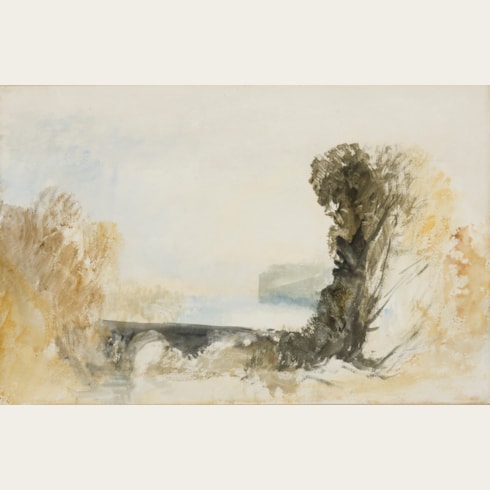Joseph Mallord William TURNER
(London 1775 - London 1851)
Shipping off the English Coast
Sold
Pencil and ink and white chalk on blue paper.
138 x 191 mm. (5 3/8 x 7 1/2 in.)
The present sheet was one of the first thirteen pages of a sketchbook – showing shipping and beach scenes - that was once in the possession of Turner’s companion Mrs. Booth, and was later acquired by the collector Laurence W. Hodson (1863-1933), who bound the drawings together with sheets from another sketchbook. Thus, some of the pages of the Hodson volume were made up of drawings on blue paper and others were on buff paper. It was Hodson who inscribed the flyleaf of the album: ‘these sketches taken out of two original sketch books of J.M.W. Turner and mounted by my directions July 1884. The books came to me direct with some other property of Turner's. Most of these sketches are written in Turner’s handwriting - well known. 46 sketches in all.’
The paper that Turner used for this drawing is a flecked blue wove watercolour paper made by George Steart of Bally, Ellen and Steart papermakers at DeMontalt Mill, Coombe Down, Bath, Somerset. According to Peter Bower, Steart was one of the most innovative paper makers of his generation and his blue wove papers were a particular favourite of Turner.
Ian Warrell has dated the drawings from this sketchbook to the 1830's.
Born in Covent Garden in London, the son of a barber, J. M. W. Turner had little formal education. He entered the Royal Academy Schools at the age of fourteen, and exhibited his first watercolour at the RA soon afterwards, in 1790. Around 1794, along with Thomas Girtin, he began to visit the home of Dr. Thomas Monro and attend the informal academy there, copying drawings from Monro’s collection, notably works by John Robert Cozens. Turner was an inveterate traveler, visiting much of Britain in his youth and in later years making several trips to the Continent, notably to France, Italy and Switzerland. On his travels, he filled numerous small sketchbooks with rapidly-drawn pencil sketches. Possessed of an exceptional visual memory, the artist was able to translate these sketchbook studies into finished watercolours or oil paintings, sometimes many months or even years afterwards. By the 1830s Turner’s technical skill and bold sense of colour allowed him to achieve remarkable effects in his watercolours, and his late works in the medium, as well as his oil paintings, found a passionate champion in John Ruskin in his seminal five-volume book Modern Painters, published between 1843 and 1860. Turner produced some eight hundred designs for engravings, which, combined with a steady stream of patrons and clients for his works in watercolour and oil, earned the artist a substantial income. In later left he became something of a recluse, and had few close friends. The artist died of cholera at his home in Chelsea in December 1851, and the contents of his studio – around three hundred paintings and over 19,000 drawings and watercolours – were eventually acquired for the nation.
Provenance
Once part of a small album, with provenance as follows:
Turner’s landlady and companion, Mrs. Booth, Margate and London
By descent to her son, John Pound
Laurence W. Hodson, Compton Hall, nr. Wolverhampton, by 1884
Thence by descent until 1978
Anonymous sale, London, Sotheby’s, 30 November 1978, lot 97
Richard L. Feigen, New York
Agnew’s, London, in 2008
Private collection, London.
Literature
Martin Butlin, J. M. W. Turner: Water Colours and Drawings, exhibition catalogue, Denver, Gallery 609, 1981, no.13.
Exhibition
Tokyo, Gallery Mitsukoshi - Nihonbashi, J. M. W. Turner, 1979, no.13
Denver, Gallery 609, J. M. W. Turner: Water Colours and Drawings, 1981, no.13.








